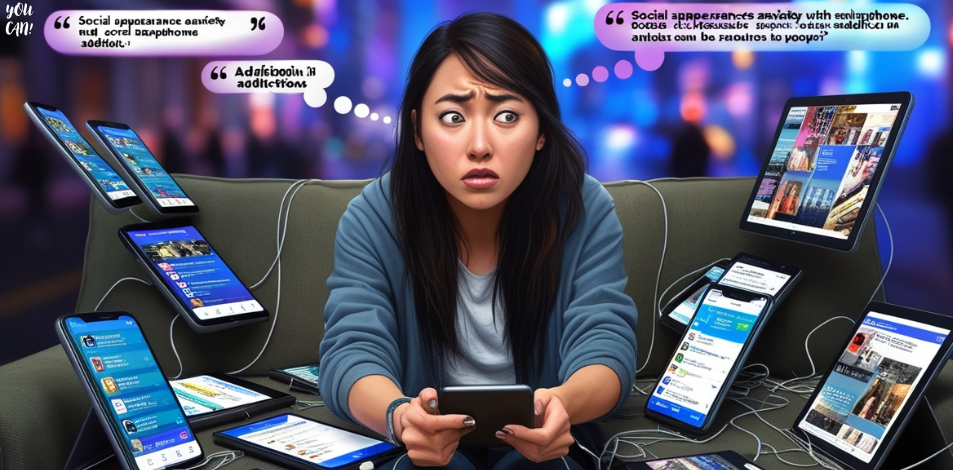
In today’s fast-paced, digitalized world, the line between our online and offline lives has become increasingly blurred. For young women, the pressures of social media can amplify insecurities, making them more susceptible to both social appearance anxiety and smartphone addiction. Although these phenomena may seem unrelated at first, there is growing evidence to suggest a hidden connection between them. This article delves into how these two modern issues intersect and affect young women, offering insights into the underlying psychological mechanisms.
Understanding Social Appearance Anxiety
Social appearance anxiety refers to the fear or worry about how others perceive one’s physical appearance. For young women, societal standards of beauty—often idealized and unattainable—can lead to heightened self-consciousness. With the advent of social media platforms like Instagram, TikTok, and Snapchat, these pressures are magnified, as users constantly compare themselves to carefully curated images of beauty, success, and happiness.
For many young women, posting selfies, fashion choices, and lifestyle snapshots becomes a performance, where the fear of judgment looms large. Comments, likes, and the number of followers serve as metrics of social validation, making the stakes even higher. This can lead to a cycle of anxiety, where young women feel compelled to present a flawless image at all times, fearing criticism or, worse, invisibility in the digital world.
The Rise of Smartphone Addiction
Smartphone addiction, or problematic smartphone use, is a growing concern in the modern world. It refers to excessive use of smartphones, to the point where it interferes with daily life. Young women, particularly, are highly susceptible to this addiction, as smartphones offer constant access to social media, entertainment, and instant communication.
Apps are designed to keep users engaged, with features like notifications, endless scrolling, and algorithm-driven content that caters to individual preferences. The fear of missing out (FOMO) on social events, news, or trends compels many to check their phones continuously. Over time, this behavior can lead to addiction, characterized by an inability to disconnect and the compulsion to stay online, even at the expense of sleep, work, or social relationships.
The Hidden Connection
While social appearance anxiety and smartphone addiction may seem like separate issues, they are, in fact, closely linked. Social media platforms, accessible via smartphones, are often the primary source of both social comparison and anxiety about appearance. Young women who are overly concerned with their appearance may spend more time on their phones, curating their online image and seeking reassurance through likes and comments.
The constant need for validation can lead to compulsive behaviors, such as repeatedly checking social media profiles or obsessively editing photos before posting. This, in turn, reinforces smartphone addiction. The more anxious young women feel about their appearance, the more they turn to their phones for temporary relief, creating a vicious cycle that is hard to break.
Psychological Impacts
The psychological effects of social appearance anxiety and smartphone addiction can be profound. Young women suffering from these issues often experience low self-esteem, depression, and anxiety. The constant pressure to look perfect online can create unrealistic expectations, making it difficult to accept oneself as they truly are.
Additionally, the addictive nature of smartphones exacerbates these feelings, as young women find it harder to disengage from the very platforms that contribute to their insecurities. This can result in a diminished sense of well-being, social isolation, and a decreased ability to focus on real-world tasks and relationships.
Breaking the Cycle
Addressing the hidden relationship between social appearance anxiety and smartphone addiction requires a multi-faceted approach. Firstly, raising awareness about the harmful effects of social comparison and unrealistic beauty standards is crucial. Young women need to be encouraged to embrace their authentic selves and resist the pressure to conform to societal expectations.
Secondly, reducing smartphone usage is key. Setting boundaries around phone use, such as designated “no-phone” times, can help break the cycle of addiction. Apps that track and limit screen time can also be beneficial in curbing excessive phone use.
Lastly, promoting mental health resources, such as therapy or counseling, can provide young women with the tools they need to cope with social appearance anxiety and smartphone addiction. Mindfulness practices, such as meditation and self-reflection, can also help in managing anxiety and fostering a healthier relationship with technology.
Conclusion
The hidden relationship between social appearance anxiety and smartphone addiction in young women is a complex issue that requires attention. By understanding the psychological drivers behind these phenomena, we can begin to address the root causes and offer support to those affected. With the right interventions, young women can learn to navigate the pressures of social media, reduce their reliance on smartphones, and ultimately, reclaim their sense of self-worth and well-being.




